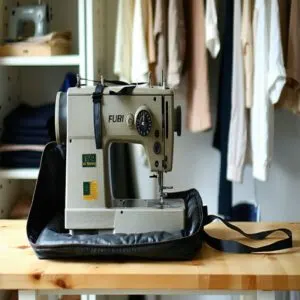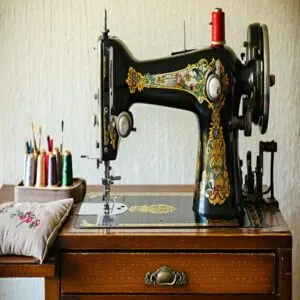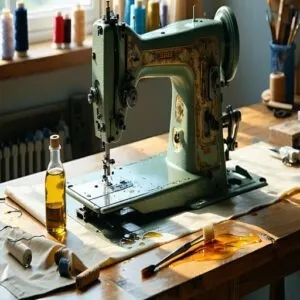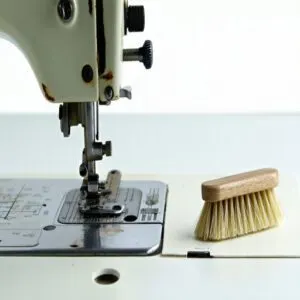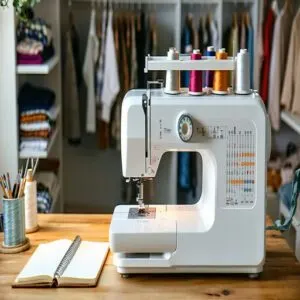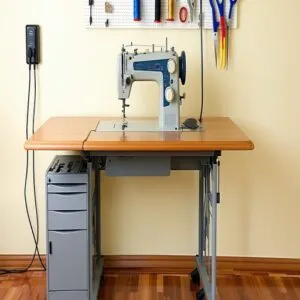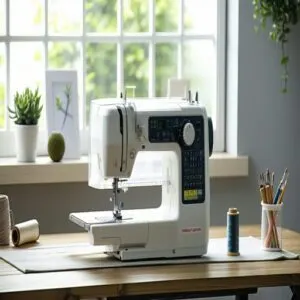This site is supported by our readers. We may earn a commission, at no cost to you, if you purchase through links.
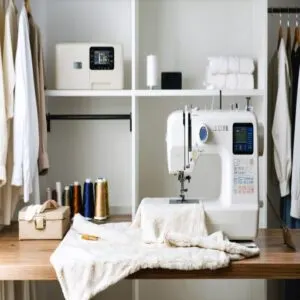
Choose a cool, dry spot like a closet or climate-controlled room – no steamy attics or freezing garages.
Cover your machine with a quality dust cover or storage case to keep it snug and protected, and give it some TLC before storage by cleaning thoroughly and oiling moving parts.
Run it briefly every few months to keep the motor purring like a kitten, which is essential for maintaining its performance and ensuring it remains in good working order.
Proper storage isn’t just about finding the right spot – it’s about creating the perfect environment where your trusty machine can rest peacefully until your next creative burst.
Table Of Contents
Key Takeaways
- You’ll want to keep your sewing machine in a cool, dry, climate-controlled space like a closet – avoid attics, basements, or garages where temperature and humidity fluctuate dramatically.
- You should protect your machine with a quality dust cover or storage case, and wrap it in soft fabric or bubble wrap for extra cushioning before storing it upright on a stable surface.
- You’ll need to maintain your stored machine by running it briefly every few months, cleaning off dust, and applying oil to moving parts according to the manufacturer’s specifications.
- You must unplug your machine when not in use and consider using a surge protector with at least 1000 joules to prevent damage to electronic components during storage.
Storing Sewing Machines Safely
When storing your sewing machine, focus on keeping it protected from dust, moisture, and extreme temperatures to prevent damage.
A cool, dry, well-ventilated space with a sturdy cover or case will help keep it in top condition for years to come.
Cool Dry Places
Long-term storage starts with a cool, dry place—think closet, not attic.
Climate control is key; high humidity can rust metal parts fast.
Spot-check humidity levels and guarantee proper air circulation to avoid mildew.
Prioritize dry storage with dust protection, like a cover or sealed case.
Regular temperature checks promote proper sewing machine maintenance.
Smart storage solutions safeguard your machine effortlessly, ensuring proper air circulation and climate control.
Avoiding Extreme Temperatures
Don’t let your sewing machine take the heat—literally!
Extreme temperatures mess with storage conditions and can damage internal parts.
Follow these storage tips:
- Avoid garages or attics with fluctuating climates.
- Opt for a temperature-controlled room for better thermal protection.
- Keep humidity levels low to prevent rust.
- Use insulated covers to buffer against sudden climate factors.
Protect your machine!
Protecting From Dust and Moisture
Keep your sewing machine spotless and safe with smart dust prevention and moisture control.
Use a dust cover or a storage case as a protective covering.
For added machine protection, pick storage solutions in cool, dry spots.
Humidity management matters—consider air purification if your space isn’t ideal.
These long-term storage tips guarantee your sewing machine stays in top shape with moisture control and smart planning.
How to Store Sewing Machine
Storing your sewing machine the right way can save you plenty of headaches down the road.
Start by prioritizing dust protection with a quality machine cover or storage bag to shield it from dirt and light.
Don’t overlook these long-term storage tips:
- Choose the right spot: A cool, dry area—like a well-ventilated closet—avoids humidity and temperature extremes that could harm your machine.
- Wrap smartly: Use protective wraps like soft fabric or bubble wrap before placing the machine in a storage bag for extra cushioning.
- Stay upright: Store the machine upright on a stable surface like a shelf or inside a sewing table to prevent tipping.
Proper sewing machine storage is essential for maintaining the longevity and performance of your sewing machine.
With these storage solutions, you’ll guarantee excellent machine protection and extend its lifespan.
Choosing Storage Options
When choosing storage options for your sewing machine, focus on both protection and accessibility.
Selecting the right storage solution, like sturdy cases or built-in cabinets, guarantees your machine stays safe and ready to use, which is crucial for accessibility.
Built-in Shelves and Drawers
For smart sewing machine storage, built-in shelves and drawers offer perfect storage solutions.
Add drawer dividers for better shelf organization and to keep tools within reach.
Cabinet designs that optimize space create tidy sewing rooms.
Use soft liners to protect surfaces and machines from scratches—ideal for long-term storage tips and maintaining sewing machine upkeep efficiently.
Proper sewing room organization, including sewing room tools, is essential for efficient storage and workflow.
Wall-mounted Cabinets and Pegboards
Pegboards and wall-mounted cabinets are perfect storage solutions for sewing machine upkeep and sewing room organization.
Install sturdy hooks for tools and create labeled shelves for a clean, accessible setup.
Think of it as vertical magic—everything’s visible, yet out of the way.
This kind of shelf management adds space while protecting machines from clutter during long-term storage.
Utilizing wall mounted cabinets can greatly enhance the overall storage capacity and efficiency of the sewing room, making it a key part of sewing room organization.
Portable Storage Containers and Carts
For sewing machine storage, choose containers sized for your machine, with durable materials that shield against dust and moisture.
Portable carts with sturdy wheels make moving a breeze, especially for compact units.
Foldable designs maximize space when not in use.
A sewing machine case offers added protection, making storage solutions practical and safe.
Effective thread storage systems can also help maintain a clutter-free workspace, making certain your machine stays secure.
These long-term storage tips guarantee your machine stays secure.
Maintaining Stored Machines
You’ll need to check on your stored sewing machine every few months to keep it in perfect working condition.
When you visit your trusty machine, clean off any dust, add a drop of oil to moving parts if needed, and run it for a few minutes to keep everything flowing smoothly.
This routine will help maintain your sewing machine.
Regular Cleaning and Lubrication
Just like a well-oiled engine, your machine needs proper maintenance for long-term storage.
Regular sewing machine cleaning and lubrication keep it running smoothly.
- Remove lint and debris using specialized cleaning tools after every project
- Apply manufacturer-recommended machine oil – just a drop or two per spot
- Check tension settings and remove needle before storage
- Use only high-quality lubricant types specified in your manual
These sewing machine maintenance steps guarantee reliable performance later.
Proper machine care involves following regular maintenance guidelines to extend its lifespan.
Checking for Damage or Corrosion
Once your cleaning routine is complete, a thorough damage inspection can spot trouble before it starts.
Check metal surfaces for early corrosion signs, especially around the faceplate and external parts where rust likes to hide.
Monthly wear detection during long-term storage helps catch metal decay early.
For effective machine preservation, pay extra attention to areas with protective coatings – they’re your first line of rust prevention.
Regularly following a sewing machine maintenance checklist can also help identify potential issues before they become major problems, which is a key part of sewing machine maintenance.
Running The Machine Occasionally
While your machine enjoys a well-deserved rest, don’t let it sleep too soundly.
Periodic testing prevents motor maintenance issues during long term storage. You’ll want to warm up your idle machine every few weeks to keep things running smoothly.
- Run the machine at various speeds for 2-3 minutes to distribute oil
- Test all stitch patterns to confirm proper function
- Check tension settings remain accurate
- Listen for unusual sounds that might signal problems
During infrequent usage, this simple machine preservation routine helps prevent seized motors and rusted parts – just like how a car needs regular starts even when parked.
Preventing Damage and Wear
You’ll need a surge protector and proper storage space to keep your sewing machine running smoothly for years to come.
When you’re storing your machine for extended periods, don’t forget to clean out dust and lint from all moving parts, as these tiny troublemakers can cause big problems later, which is why regular maintenance is crucial for proper storage.
Using Surge Protectors
You’ve invested in your sewing machine, so protect it with a high-quality surge protector while it’s in storage.
These circuit protection devices regulate voltage and shield your machine’s sensitive computerized components from unexpected power spikes.
Choose a surge protector with multiple outlets and at least 1000 joules of protection.
It’s a small investment that’ll save you from costly electrical repairs down the road.
When selecting a surge protector, consider purchasing from a reliable Surge Protector Outlet to guarantee maximum protection for your sewing machine.
Avoiding Power Surges
By taking preventive measures against power surges, you’ll safeguard your sewing machine’s electronic components.
Always unplug your machine when not in use, especially during storms, and distribute your electrical load wisely by avoiding multiple devices on one outlet.
For maximum electrical safety, consider installing dedicated outlets and voltage regulators in your storage area.
Understanding and following proper sewing safety precautions is essential for maintaining your equipment.
You’ll thank yourself when the next lightning storm hits.
Inspecting Machines for Dust and Debris
While power surges threaten your machine’s electronics, dust and debris pose equally sneaky risks.
Regular checkups help you spot trouble before it starts – check your bobbins area and feed dogs monthly for lint buildup.
A soft brush and compressed air make quick work of debris removal.
Don’t forget hidden spots behind the needle plate and presser foot where dust loves to hide.
Extending Sewing Machine Lifespan
You’ll extend your sewing machine’s life by keeping it in a cool, dry place and protecting it from dust with a proper cover during long-term storage.
Your machine’s components will stay in top condition if you run it occasionally and use quality thread and needles when it’s time to sew again.
Proper Storage and Maintenance
Your sewing machine’s lifespan hinges on proper storage and regular maintenance schedules.
Place it in a climate-controlled space with steady humidity control, wrapped in soft fabric for machine protection.
Implement monthly cleaning methods using a soft brush for the bibbon area and moving parts.
For long-term storage tips, consider using silica gel packets in your storage solution to prevent moisture damage.
Replacing Worn Components
Regular component replacement keeps your sewing machine running like clockwork.
Before starting repairs, unplug your machine and gather your manual along with proper tools.
For reliable part sourcing, check local repair shops, manufacturer websites, or trusted online retailers.
Remove the machine’s casing carefully, swap out worn components, and always test thoroughly after repairs to confirm everything’s working smoothly.
Always ensure you have followed the necessary steps to keep your machine in good condition, and remember that proper tools are essential for successful repairs.
Using High-Quality Thread and Needles
Now that you’ve replaced worn parts, your thread selection and needle care directly impact your machine’s future.
High-quality thread prevents lint buildup and tension issues during storage, while fresh needles protect internal components.
- Your thread choice affects more than stitches – it’s your machine’s lifeline
- Premium threads reduce friction on key parts
- Fresh needles prevent microscopic fabric damage
- Proper needle size keeps your machine’s timing in sync
Choose thread that matches your fabric quality, and always start long term storage with a new needle installed. This sewing machine maintenance step prevents hidden wear during dormant periods.
Frequently Asked Questions (FAQs)
How do you store a sewing machine if not in use?
Place your machine in a cool, dry cabinet with a dust cover, unplugged from power.
You’ll want to make certain it’s oiled and cleaned first, then wrap it in soft fabric for protection.
How to maintain a sewing machine?
Your sewing machine’s health matters. Make cleaning a priority after each use, oil moving parts monthly, change needles every 8 hours of sewing, and schedule professional tune-ups yearly for peak performance.
How to store a sewing machine in a temperature controlled locker?
Wrap your machine in soft fabric, secure it in a sturdy plastic container, and position it upright in your temperature-controlled locker.
You’ll want to check monthly for any moisture buildup or condensation issues.
How often should a sewing machine be serviced?
Time flies when you’re stitching, but don’t let your machine lose its groove.
You’ll want professional servicing every 1-2 years, plus quick tune-ups after 6-8 hours of heavy sewing to maintain peak performance.
How to clean a sewing machine?
Use a soft brush to remove lint from the bobbin case, thread take-up lever, and presser foot.
You’ll want to apply sewing machine oil to moving parts after cleaning, following your manual’s guidance.
Do you need to oil your sewing machine?
Yes, you’ll need to oil your machine every 6-8 hours of sewing, unless it’s self-lubricating.
Check your manual first, then apply 1-2 drops of machine oil to moving parts for smooth operation.
How to store a sewing machine when not in use?
A dust cover shields your machine in a cool, dry cabinet.
You’ll want to skip basements and attics – stick to climate-controlled spots.
Protect it with surge protectors and unplug when you’re done.
Should you store a sewing machine with the foot up or down?
For ideal protection, you’ll want to store your sewing machine with the presser foot down.
This keeps tension on your feed dogs and prevents unnecessary stress on the presser foot spring mechanism.
Where is the best place to store a sewing machine?
A cool, dry cabinet or closet inside your home is perfect for your sewing machine.
You’ll want to avoid basements, attics, and garages where temperature changes and humidity can damage delicate parts.
What is the average lifespan of a sewing machine?
Today’s mechanical workhorses can hum along for 20-30 years, while their computerized cousins typically give you 10-15 years of faithful service.
You’ll get the most years when you maintain them with regular care.
Conclusion
Just as a gardener nurtures their prized plants, your sewing machine deserves careful attention when storing it for long periods.
By following these expert tips, you’ll keep your machine in prime condition, ready to spring back into action whenever inspiration strikes.
Remember to store it in a cool, dry place, perform regular maintenance checks, and give it occasional test runs.
With proper care and storage techniques, your trusted companion will continue crafting beautiful creations for years to come.
- https://singeroutlet.co.uk/blogs/news/how-to-store-your-sewing-machine
- https://craftspaceideas.com/how-to-store-a-sewing-machine-so-it-doesnt-get-damaged/
- https://storables.com/articles/how-to-store-a-sewing-machine/
- https://craftysewingsew.co.uk/how-to-store-your-sewing-machine-solutions-to-long-and-short-term/
- https://sewing.patternreview.com/SewingDiscussions/topic/41394

